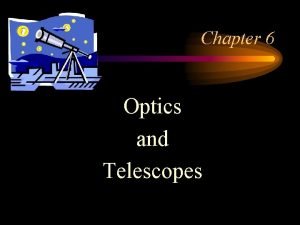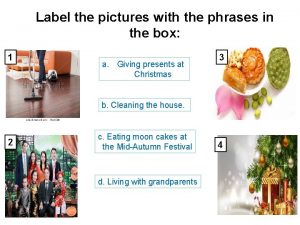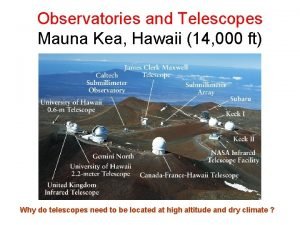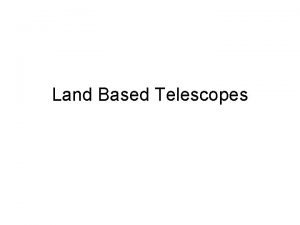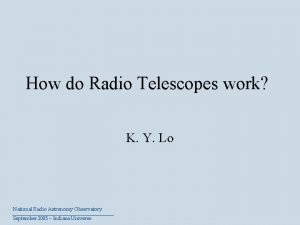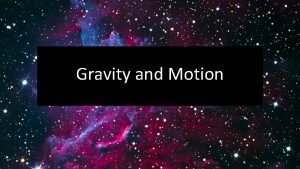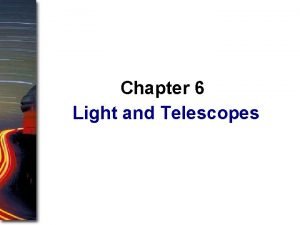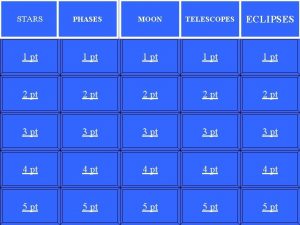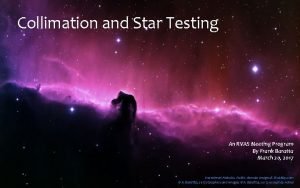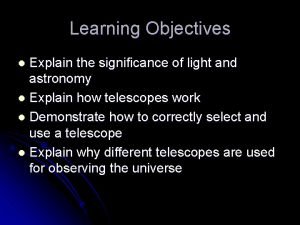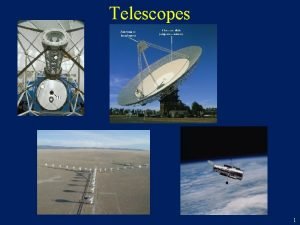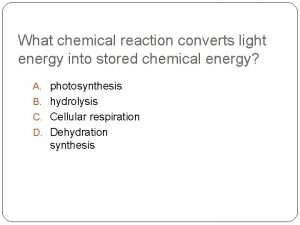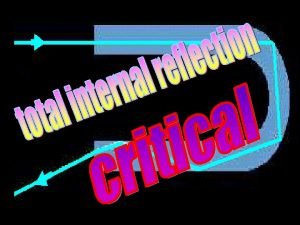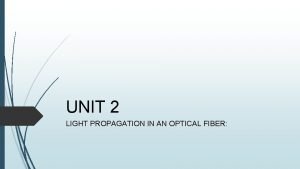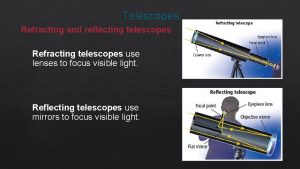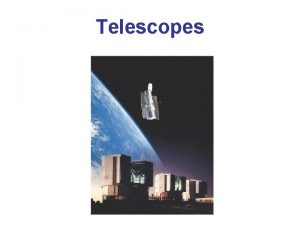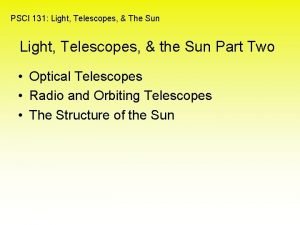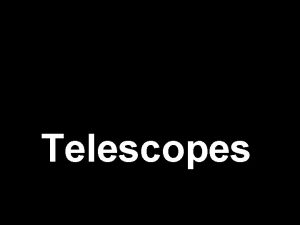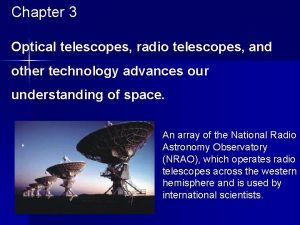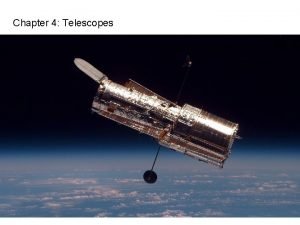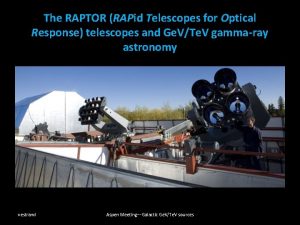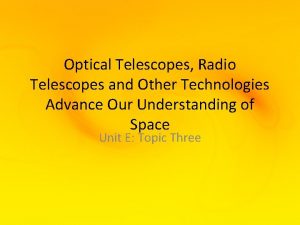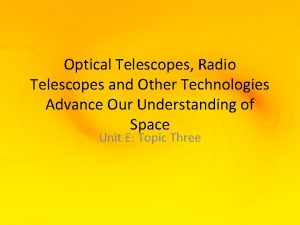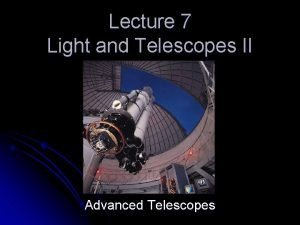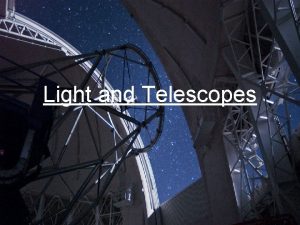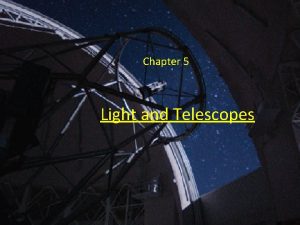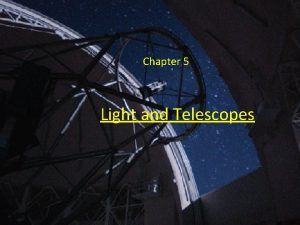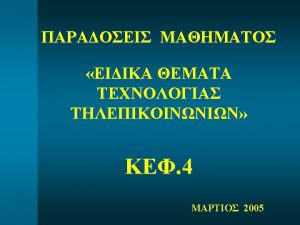Optical telescopes Ones that use light energy Functions































- Slides: 31

Optical telescopes Ones that use light energy

Functions of telescopes l Two uses l l l 1. Gather more light 2. Magnify objects Locations l l l 1. High elevations 2. Dry climates 3. Remote areas

Optical telescopes l l Power depends on lens/mirror area 1. Radius x 2 = 4 x’s l Usually kept in a dome l l 1. Protects from weather 2. Controls temperature

Refracting telescopes l l Simplest type 2 lenses l 1. Objective l l 2. Eyepiece l l l a. collects image b. bigger size c. bends light a. smaller b. magnifies Most made before 1900’s

Refracting telescope Notice the size of people

Reflecting telescopes l l l Uses mirrors like a periscope Two types of manufacturing l l 1. Solid piece ground and polished 2. “spin cast” l a. spun while warm to curve wanted

Reflecting telescope Size is much larger

Multiple mirror reflections (MMT) l l l Uses several mirrors to simulate 1 large Easier to maintain VLT- very large telescope l 1. 4 -8. 2 m mirrors = 1 -16 m mirror in light gathering but 160 m in resolution

Schmidt telescope l l l Located in most major areas Utilize a combination reflecting and refracting Used to take wide angle pictures primarily

Hubble telescope l l l Named after Edwin Hubble Imperfect lens 8’ diameter mirror Contains spectrograph and infrared Being replaced by the James Webb in 2015

Photographic plates l l l Allow for extended light gathering Record positions of celestial objects Comets found

Charge-coupled device (CCD) l l More sensitive to light Absorbs a broader spectrum Photocells containing electrons are used Electrons are stored in areas of high energy concentration

Comparison of photograph and CCD Photograph CCD

Electromagnetic spectrum l l Energy waves traveling at 300, 000 Km/s in space separating types l 1. Use frequency and wavelength l l l a. frequency = # of waves passing a point per/sec b. wavelength = dist from crest to crest c. inversely proportional

Radio astronomy l l Study of radio waves from space Radio waves l l l 1. Lowest frequency (longest length) 2. Received from areas that appear optically empty 3. Unaffected by atmosphere and light conditions

Radio telescopes l l l Bowl shaped antennas Receiver is located above and is movable Larger than optical telescopes due to material used and wave sizes l l l 1. Steel mesh rather than glass 2. Smallest is 26 m Largest is located in Puerto Rico

Puerto Rican telescope (Aricebo)

Radio telescope arrays l Use multiple units to simulate one large l l l Infererometry l l 1. Distance between dishes = baseline 2. 2 small at 100 m = 1, 100 m dish 1. difference in arrival times to determine distance away Increased baseline improves accuracy in details and depth

Example of use

Newest and bestest l Paranal observatory in Chilean mountains

Other wavelengths l l UV, X-ray, and gamma rays are absorbed by the atmosphere Studied with balloons, rockets and satellite Located new items - Black holes, galaxies Infrared telescopes l l l 1. Must be supercooled 2. Located from any source of heat 3. IRAS -located in space used liquid helium as a coolant (a short 10 month supply)

Major concepts (test material) l l l Function of telescopes Types of telescopes (reflective, refractive, radio, infrared) Use of arrays Restrictions for infrared telescopes Electromagnetic spectrum Ways to improve images

Spectroscope l White Light is made of all colors l l 1. Roygbv Spectroscopes major parts are l l l 1. Prism- separates light 2. Lens focuses/magnifies light 3. Camera - photographic plate or CCD

Major uses of spectroscope l Determine the following of stars l l l 1. Makeup / materials 2. Temperature 3. Pressure 4. Magnetic field 5. Condition of gases/ life stage

3 types of visible spectra Continuous Bright line Emmision Dark line absorption

Continuous l l Unbroken band of colors Can come from 3 kinds of materials l l l 1. Glowing solids 2. Glowing liquids 3. Hot, compressed gas

Bright line l l l Unevenly spaced series of lines of different colors and brightness limited wavelengths are emitted sometimes called emission spectrum source- glowing gas or vapor each element produces unique spectrum

Dark line spectrum l l Continuous spectrum with dark lines where light is absorbed Also called absorption spectrum Light passes through cooled gas, energy is absorbed by gas Dark band are unique to each element

Uses for dark line spectra l l Atmosphere of sun works as absorption filter Determine planets atmosphere, if different than suns, the spectra will be different

The Doppler effect l l Spectrum analysis noted shifts in bright line Caused by movements to or from earth 1. Red = increasing distance, longer wavelengths received 2. Blue = decreasing distance, shorter wavelengths received

Major Concepts l l l 1. Use of spectroscope Types of visible spectra Doppler effect
 All modern large optical telescopes are refractors.
All modern large optical telescopes are refractors. Light light light chapter 23
Light light light chapter 23 Light light light chapter 22
Light light light chapter 22 Light light light chapter 22
Light light light chapter 22 Ngoại tâm thu thất chùm đôi
Ngoại tâm thu thất chùm đôi Block xoang nhĩ độ 2 type 1
Block xoang nhĩ độ 2 type 1 Thể thơ truyền thống
Thể thơ truyền thống Thơ thất ngôn tứ tuyệt đường luật
Thơ thất ngôn tứ tuyệt đường luật Walmart thất bại ở nhật
Walmart thất bại ở nhật Tìm vết của mặt phẳng
Tìm vết của mặt phẳng Con hãy đưa tay khi thấy người vấp ngã
Con hãy đưa tay khi thấy người vấp ngã Tôn thất thuyết là ai
Tôn thất thuyết là ai Gây tê cơ vuông thắt lưng
Gây tê cơ vuông thắt lưng Sau thất bại ở hồ điển triệt
Sau thất bại ở hồ điển triệt One/ones grammar
One/ones grammar Form phrases. use appropriate ones to label the pictures
Form phrases. use appropriate ones to label the pictures A building that contains one or more telescopes
A building that contains one or more telescopes Chromatic aberration affects reflector telescopes
Chromatic aberration affects reflector telescopes Land based telescopes
Land based telescopes Computer controlled telescopes
Computer controlled telescopes How do radio telescopes work
How do radio telescopes work Modern telescopes make it possible for astronomers
Modern telescopes make it possible for astronomers Guidepost of light
Guidepost of light New moon telescopes
New moon telescopes Star testing telescope
Star testing telescope History of telescopes timeline
History of telescopes timeline Refracting telescopes exhibit great focus and color.
Refracting telescopes exhibit great focus and color. How do telescopes work
How do telescopes work ________ converts light energy into chemical energy. *
________ converts light energy into chemical energy. * Photosynthesis transforms light energy into chemical energy
Photosynthesis transforms light energy into chemical energy When light travels from an optically denser medium
When light travels from an optically denser medium Angle of acceptance cone is twice the
Angle of acceptance cone is twice the
